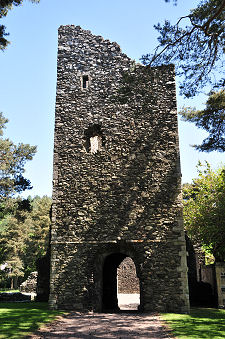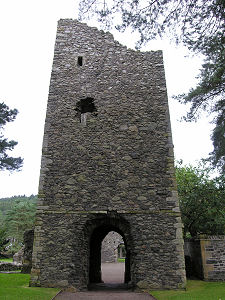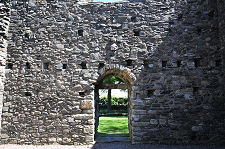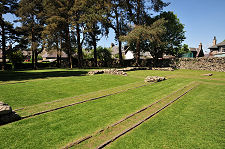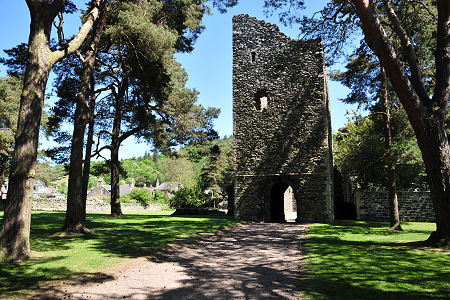 The Ruins of Cross Kirk from the Road |
The gaunt ruins of Cross Kirk stand in a slightly wooded enclosure in a quiet residential area to the north-west of the centre of Peebles. What you find are the remains of a religious complex founded by the Trinitarian order, also known as the Redfriars, in the late 1100s.
The traditional story is that the religious associations of the site date back to 1261, when a cross and relics of St Nicholas of Myrna were discovered hidden here. St Nicholas was a Bishop of Myrna, in modern Turkey, in the early 300s, and has since been revered as a saint across large parts of Europe, becoming the patron saint of sailors amongst others. He was also the origin of the story of Santa Claus.
Quite how St Nicholas's relics are meant to have found their way to Peebles is unrecorded, but they were said to have been discovered here in the presence of King Alexander III, and a number of miracles occurred as a result. In response the king founded a priory here. The first mention of the priory's actual existence dates back to in 1296 when its prior swore fealty to Edward I of England (along with much of the rest of the great and the good of Scotland) at Berwick-upon-Tweed. (Continues below image...)
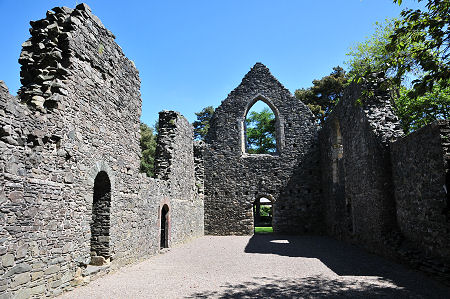 Inside the Church, Looking East |
As originally built, the priory comprised a simple rectangular church with no obvious segregation between the nave and the choir. The domestic buildings of the priory were built to the north of the church. This was unusual, because it was the norm for such buildings to be to the south of the church where they would not stand in its shadow.
In 1474, the status of the priory was increased to that of a monastery, and a stone bell tower was built at the church's west end. Probably around the same time, a stone cloister was built to replace the old domestic buildings, again to the north of the church. The Reformation of 1560 brought an end to Cross Kirk's existence as a monastery and thereafter it served as the parish kirk, replacing St Andrew's Church, which had been burned down by the English in 1548. In 1656 the church was shortened, with the old choir being turned into a schoolroom. Around the same time a number of burial aisles were built on either side of the church for important local families. An inscription over a doorway at the east end of the church is dated 1656.
Cross Kirk was abandoned in 1784 when a new parish church was built to serve Peebles. A visitor in 1790 found the church almost complete except for its roof, though it seems that the monastery's domestic buildings had long since been dismantled for their stone. By the late 1800s Cross Kirk was being described as a fragmentary ruin in a fir plantation on the edge of Peebles, and having a "very desolate appearance".
The ruins of Cross Kirk are today cared for by Historic Environment Scotland, and they now lie within an expanded Peebles rather than on its edge. What you find is a tranquil grassy glade, which is home to a still impressive ruin. The bell tower at first seems to be the most complete part of the structure, though it is pretty ruined when seen from the inside of the church. The height of the nave walls still give Cross Kirk a powerful presence. Traces are visible of the later burial aisles, but not much remains of the rest of the monastic complex beyond partial foundations.
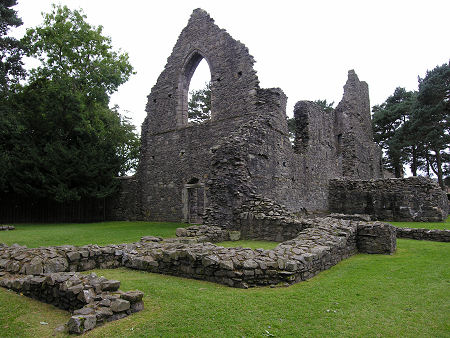 Cross Kirk from the North-East |

|
|
|
Visitor InformationView Location on MapGrid Ref: NT 251 407 www.historicenvironment.scot HES: Kirk Web Page Open all year and admission is free. What3Words Location: ///comic.handsets.spoil |
 Inscription: God 1656 |
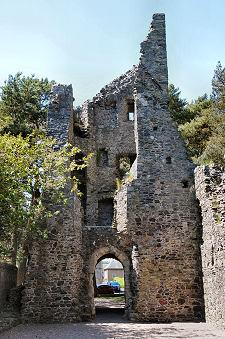 Interior of the Tower |
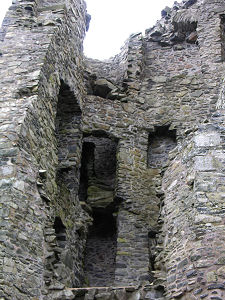 Closer View of Tower Interior |
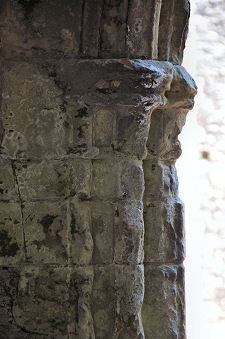 Doorway Detail |
